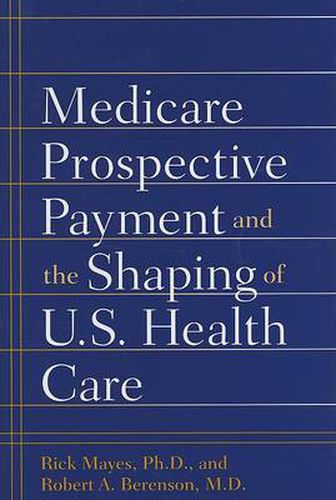Readings Newsletter
Become a Readings Member to make your shopping experience even easier.
Sign in or sign up for free!
You’re not far away from qualifying for FREE standard shipping within Australia
You’ve qualified for FREE standard shipping within Australia
The cart is loading…






This is the definitive work on Medicare’s prospective payment system (PPS), which had its origins in the 1972 Social Security Amendments, was first applied to hospitals in 1983, and came to fruition with the Balanced Budget Act of 1997. Here, Rick Mayes and Robert A. Berenson, M.D., explain how Medicare’s innovative payment system triggered shifts in power away from the providers (hospitals and doctors) to the payers (government insurers and employers) and how providers have responded to encroachments on their professional and financial autonomy. They conclude with a discussion of the problems with the Medicare Modernization Act of 2003 and offer prescriptions for how policy makers can use Medicare payment policy to drive improvements in the U.S. health care system. Mayes and Berenson draw from interviews with more than sixty-five major policy makers-including former Treasury secretary Robert Rubin, U.S. Representatives Pete Stark and Henry Waxman, former White House chief of staff Leon Panetta, and former administrators of the Health Care Financing Administration Gail Wilensky, Bruce Vladeck, Nancy-Ann DeParle, and Tom Scully-to explore how this payment system worked and its significant effects on the U.S. medical landscape in the past twenty years. They argue that, although managed care was an important agent of change in the 1990s, the private sector has not been the major health care innovator in the United States; rather, Medicare’s transition to PPS both initiated and repeatedly intensified the economic restructuring of the U.S. health care system.
$9.00 standard shipping within Australia
FREE standard shipping within Australia for orders over $100.00
Express & International shipping calculated at checkout
This is the definitive work on Medicare’s prospective payment system (PPS), which had its origins in the 1972 Social Security Amendments, was first applied to hospitals in 1983, and came to fruition with the Balanced Budget Act of 1997. Here, Rick Mayes and Robert A. Berenson, M.D., explain how Medicare’s innovative payment system triggered shifts in power away from the providers (hospitals and doctors) to the payers (government insurers and employers) and how providers have responded to encroachments on their professional and financial autonomy. They conclude with a discussion of the problems with the Medicare Modernization Act of 2003 and offer prescriptions for how policy makers can use Medicare payment policy to drive improvements in the U.S. health care system. Mayes and Berenson draw from interviews with more than sixty-five major policy makers-including former Treasury secretary Robert Rubin, U.S. Representatives Pete Stark and Henry Waxman, former White House chief of staff Leon Panetta, and former administrators of the Health Care Financing Administration Gail Wilensky, Bruce Vladeck, Nancy-Ann DeParle, and Tom Scully-to explore how this payment system worked and its significant effects on the U.S. medical landscape in the past twenty years. They argue that, although managed care was an important agent of change in the 1990s, the private sector has not been the major health care innovator in the United States; rather, Medicare’s transition to PPS both initiated and repeatedly intensified the economic restructuring of the U.S. health care system.